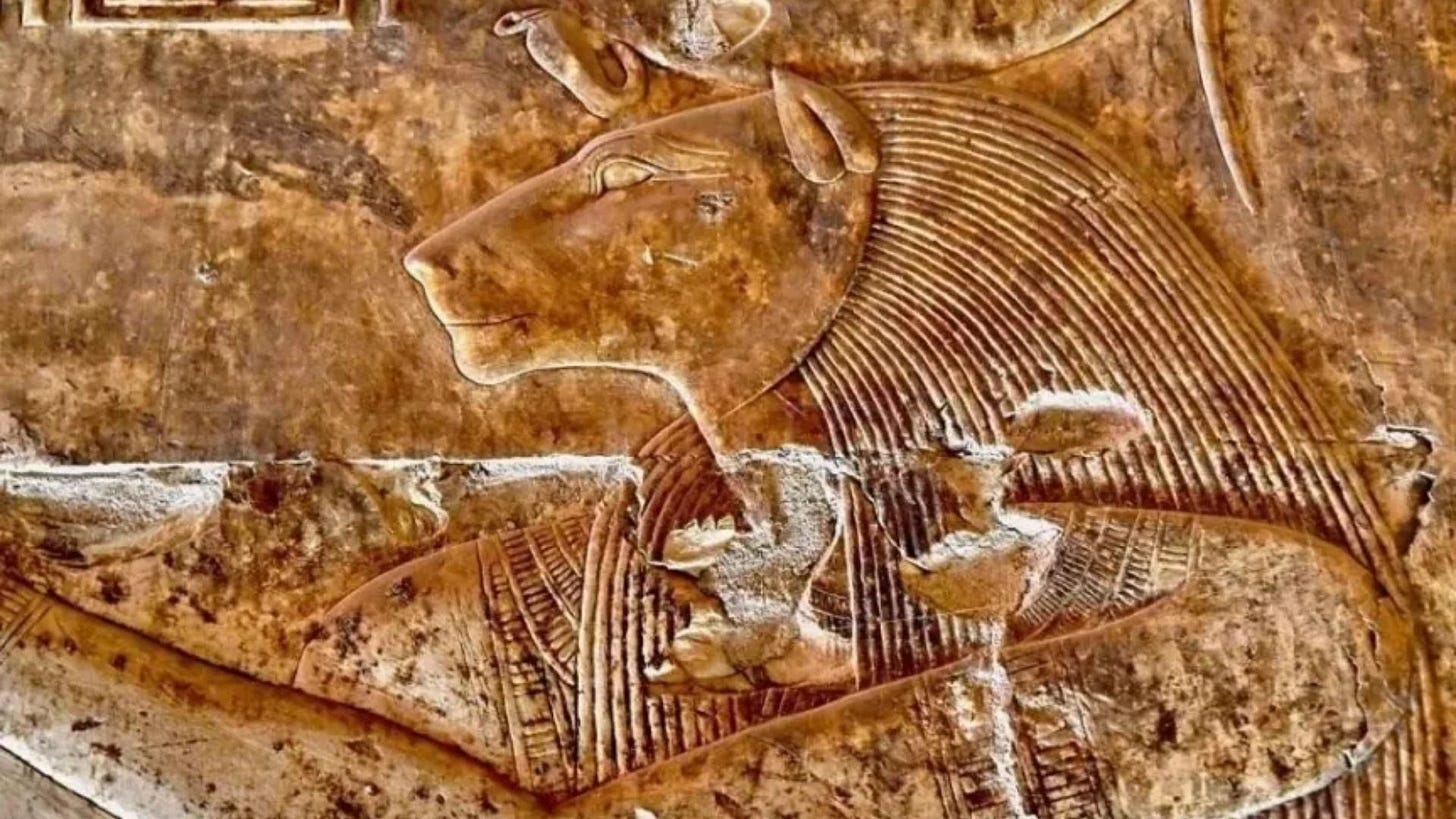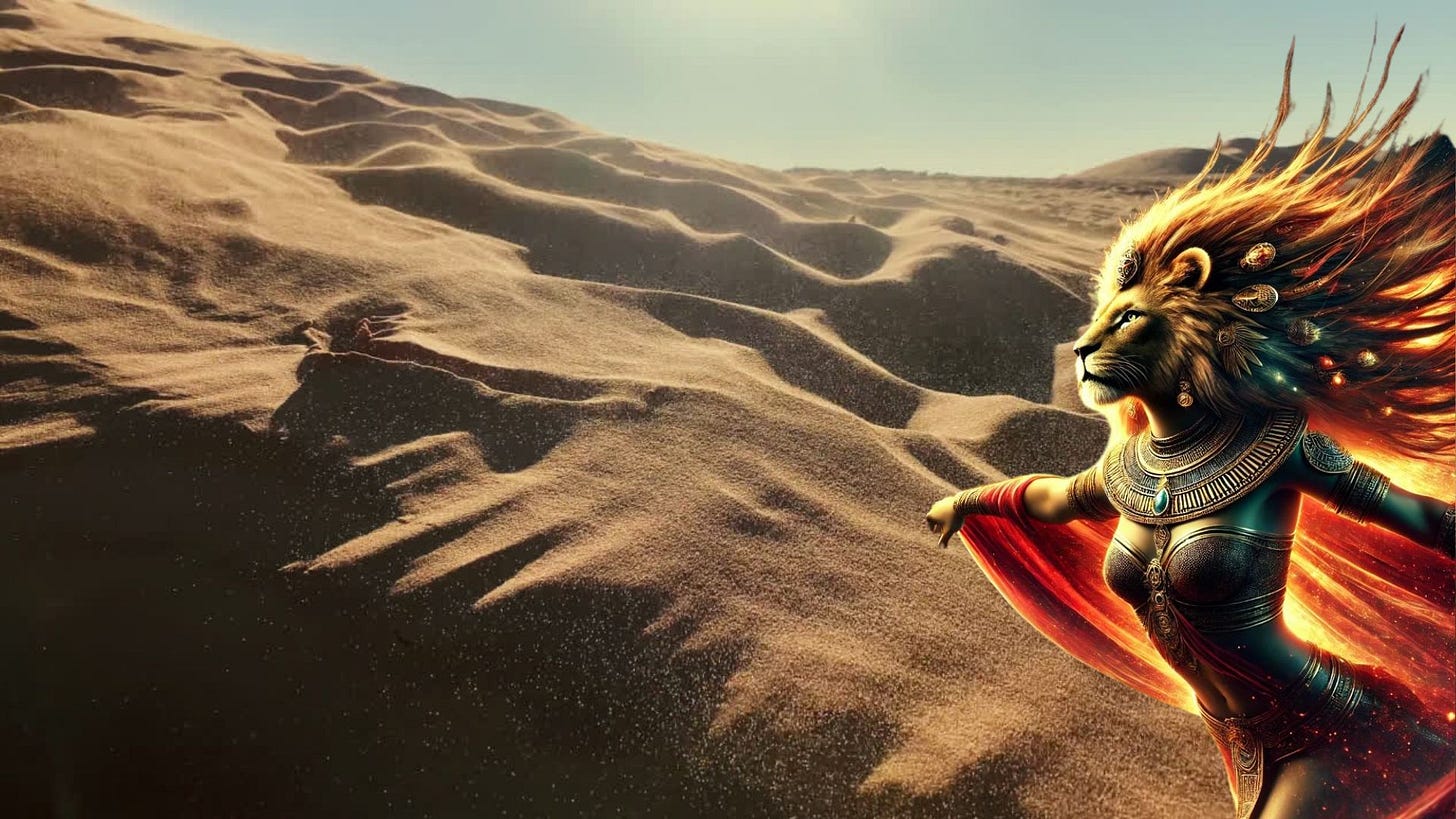Sekhmet’s name comes from the root sḫm—meaning “power” or “might.” Her name means “The Powerful One.” She’s almost always depicted as a lion-headed woman wearing a solar disk and the uraeus, the royal cobra. With her fiery breath, she burns enemies to ash. With her sharp claws, she defends the sun god Re. And yet… she’s also worshipped as a healer and protector against plague. It’s this paradox, fury and healing, chaos and restoration, attributes that make Sekhmet one of the most compelling figures in Egyptian mythology.
Before we focus on Sekhmet herself, we must confront a paradox at the core of Egyptian cosmology: Why do female gods, who are typically associated with nurturing, appear to go against their feminine nature and engage in killing? In myth after myth, it is not the male gods who carry out divine punishment, it is the female gods. Sekhmet, Mut, Hathor, Tefnut, Bastet, and others, all embodiments of feminine energy, also wield terrifying, divine violence. In most modern cultures, especially in patriarchal religious traditions, power and violence are usually gendered male. Not so in Egypt.
In the myth of the Eye of Re, one of the central myths explaining Sekhmet's role, the sun god Re sends his Eye—a blazing, radiant feminine force—to punish humanity for their rebellion. That Eye becomes Sekhmet. It is not Re who does the killing. It is the female Eye. She descends upon the world as a lioness, and she slaughters humans by the thousands.
Why is the Eye of Re female? Why is divine wrath often depicted as feminine in this mythology?
This is not just a minor aspect of Egyptian religion. It is central. And when we compare it to the myth of the Distant Goddess, in which this same female Eye goes rogue and must be coaxed back to restore harmony, we realise something crucial: The feminine divine is the active, mobile, and volatile force of divine order. Male gods create and sustain, but female gods enforce. Female gods cleanse. Female gods purge the rot.
This was not seen as cruel—it was seen as necessary. Just like a lioness hunts not for pleasure but for survival, Sekhmet kills to restore balance.
Sekhmet: The Bloodthirsty Eye of Re
Sekhmet is often introduced as the lion-headed goddess of war, but that hardly captures the complexity of her role. In fact, Sekhmet is the manifestation of Re's anger. She is his Eye when it turns toward punishment. She is the flame that burns away chaos.
According to the myth of the Eye of Re, humanity had begun plotting against the ageing sun god. Re, no longer as vigorous as he once was, hears of this rebellion and sends out his Eye—the blazing force of divine justice. But when this Eye takes form, she becomes Sekhmet, the lioness of Upper Egypt. And what follows is not just punishment, it is a massacre. Sekhmet slaughters humans so ferociously that she nearly wipes them out.
The blood flows like rivers. The sand turns red. And Re realises that Sekhmet has become unstoppable. Even the creator god himself cannot control the wrath he has unleashed in the female. This is why he must trick her—he dyes beer red to look like blood, lays it across the battlefield, and Sekhmet, fooled, drinks it, falls into a drunken sleep, and calms. She is restored. Balance returns.
But consider this: in the most famous Egyptian myth of divine punishment, the act of violence is entirely attributed to a female deity. The sun god Re is protected and avenged not by himself but by his lioness daughter. Just like a male lion who leads in name but whose pride of lionesses does the real hunting and defending, Re's power is inseparable from the power of his lioness goddesses.
Lionesses, Order, and Divine Protection
To understand why this makes sense to the ancient Egyptian mind, we must examine the symbolism of the lioness. The ancient Egyptians knew their environment. They watched animals closely and understood it was the lioness, not the lion, that was the ultimate predator of the plains. She hunted, she defended the pride, and she raised the cubs. She was fast, strong, and merciless when it came to protecting her own.
So, when Egyptian myth tells us that Re is guarded by the Eye by Sekhmet, it uses the lioness as the perfect metaphor. Re is the source of light and life, but he cannot preserve his order alone. The cosmos is full of threats, demons, chaos, serpents, and rebellion, and only the divine lionesses are capable of responding with the necessary force.
This is where the myth of the Distant Goddess comes in. In this story, the Eye of Re has left Egypt to travel to Nubia, a remote region in the south. The myth concerns the apparent movement of the overhead sun. The sun appears to leave Egypt when it reaches its zenith at the Tropic of Cancer, located near Aswan, after the Summer Solstice, and then travels south. Today, we know this is part of the natural cycle of the seasons, but the Egyptians worried that the sun would fail to return. The return of the sun around the time of the solstice was connected with the arrival of the annual flood in the ancient Egyptian mind, and so they believed they had to intervene to ensure their vital cosmic cycles were maintained. Additionally, without his Eye, they believed Re was vulnerable, so the Eye must be restored. So, the gods set off to retrieve her; they do not do so by force but instead use trickery, music, beer, and wine.
In both myths, the Eye of Re and the Distant Goddess, the pattern is the same. Female divine power is unleashed. It becomes too powerful. Then, it must be appeased and brought back into cosmic harmony. The Eye is the guardian of Re, but she is also his chief risk. Divine power, in female form, is both protector and destroyer.
Sekhmet and Her Many Faces
Now, here's where it gets even more interesting. Sekhmet isn't just one lioness goddess. She exists in a divine ecosystem of multiple overlapping, feline deities, all of whom embody aspects of the Eye of Re. These include:
Hathor, who in some myths is the same as Sekhmet after she calms down.
Tefnut, another aspect of the fiery Eye and the daughter of Re.
Mut, the great mother goddess, can take the form of a lioness.
Bastet, the feline goddess, is often depicted as a domestic cat, but in earlier periods, she is also shown as a lioness.
Menhit, a lesser-known lioness goddess of war, is also part of the Eye complex.
This collective is often referred to as the Seven Arrows of Sekhmet or the Seven Hathors, depending on the context. These goddesses could both bless and curse. They could heal or destroy. They represent the ambiguous and wild nature of female divine power, primarily when associated with the Eye of Re.
And let's not forget that Sekhmet was also a healer. Her priests were highly trained doctors. She had the power to strike with plague—or to cure it. Once again, we see the dual nature: the lioness who both kills and heals. This wasn't a contradiction in ancient Egyptian thought—it was a demonstration of divine completeness.
Why This Matters: The Gender of Power in Ancient Egyptian Myth
So why did the Egyptians envision divine punishment, cosmic cleansing, and sacred violence in female form? What does it mean that Sekhmet, and not Re, is the one who kills? Is the Eye of Re always feminine? Is the Distant Goddess the one whose return restores life?
The answer lies in how ancient Egyptians saw power, order, and danger. Male gods, such as Re, Ptah, or Osiris, are often depicted as creators, sustainers, and judges. But when it comes to action, especially violent, necessary action to preserve Ma'at, the natural and divine order, it is the female gods who act. They are mobile, fiery, and uncontainable. They represent that which moves between worlds from heaven to earth, from creation to destruction, from wrath to mercy.
The lioness goddess, in all her forms, is the living expression of that terrifying and sacred threshold. Sekhmet is not just a war goddess. She is the knife at the throat of chaos. She is the last line of defence. She is divine rage in the service of balance.
So, the next time you see an image of Sekhmet's stone-cold eyes, lioness head, and sun disk blazing, remember: you're not just looking at a goddess of war; you're looking at the embodiment of a cosmic philosophy. A system that recognised that sometimes, to keep the world alive, you have to unleash the lioness.










I have so much to say about Ancient AEgyptian Sacred Science of the Stars I not sure where to start so I've decided with my last dream early this Australian morning re the 50,000 year Sothic ie Sirian anniversary now happening as Jupiter begins its yearly transit of Cancer where in the middle 13 & 14 degrees reside Sirius both the brightest and only star of the entire heavens that doesn't move proving that this star with its 50 year rotation aka Jubilee
The Egyptian religion was solar in general, and there are a number of solar goddesses such as Sekhmet and Hathor, who were incredibly popular and important. Dedications and shrines to Hathor are among the most popular at the Deir el Medina village, and she is later associated with Ma'at, the cosmic order herself. As you point out, she is the "calmed down" version of Sekhmet, but she is hardly passive: she is the goddess of joy and exuberance and beauty, in a very extraverted manner, "projecting power" just as as Sekhmet, only as a warming sunlight rather than fiery ray of death. Truly both of these deities are worth considering as complimentary forms within a solar schema.